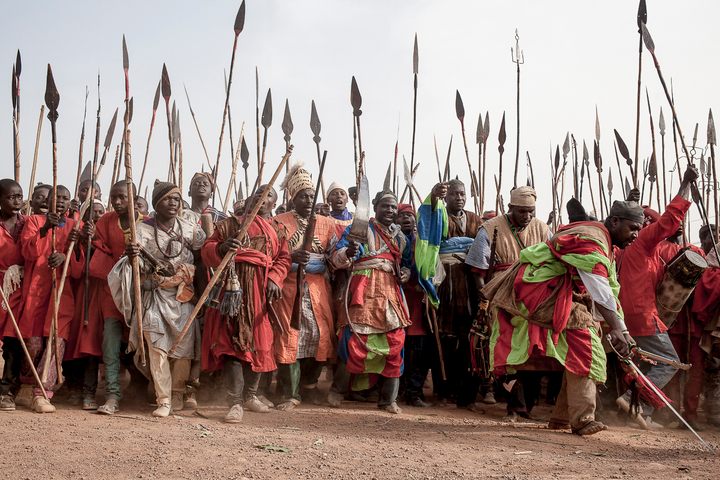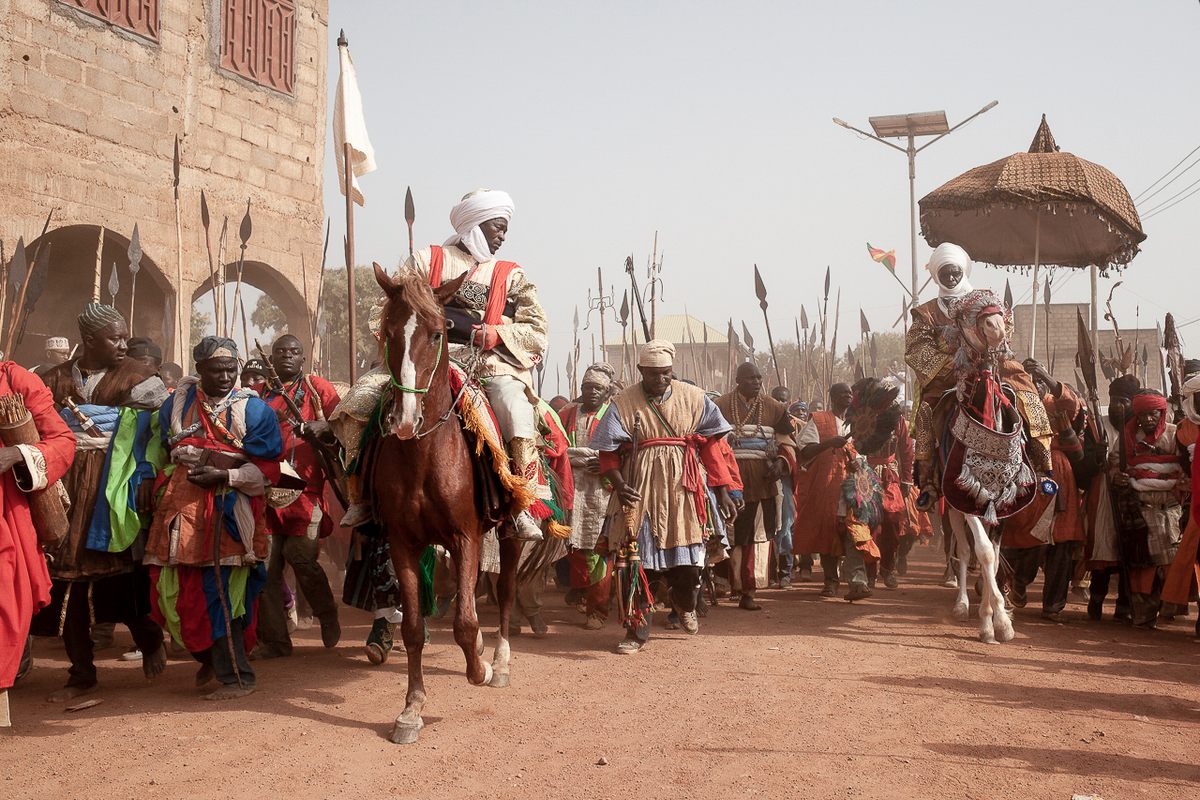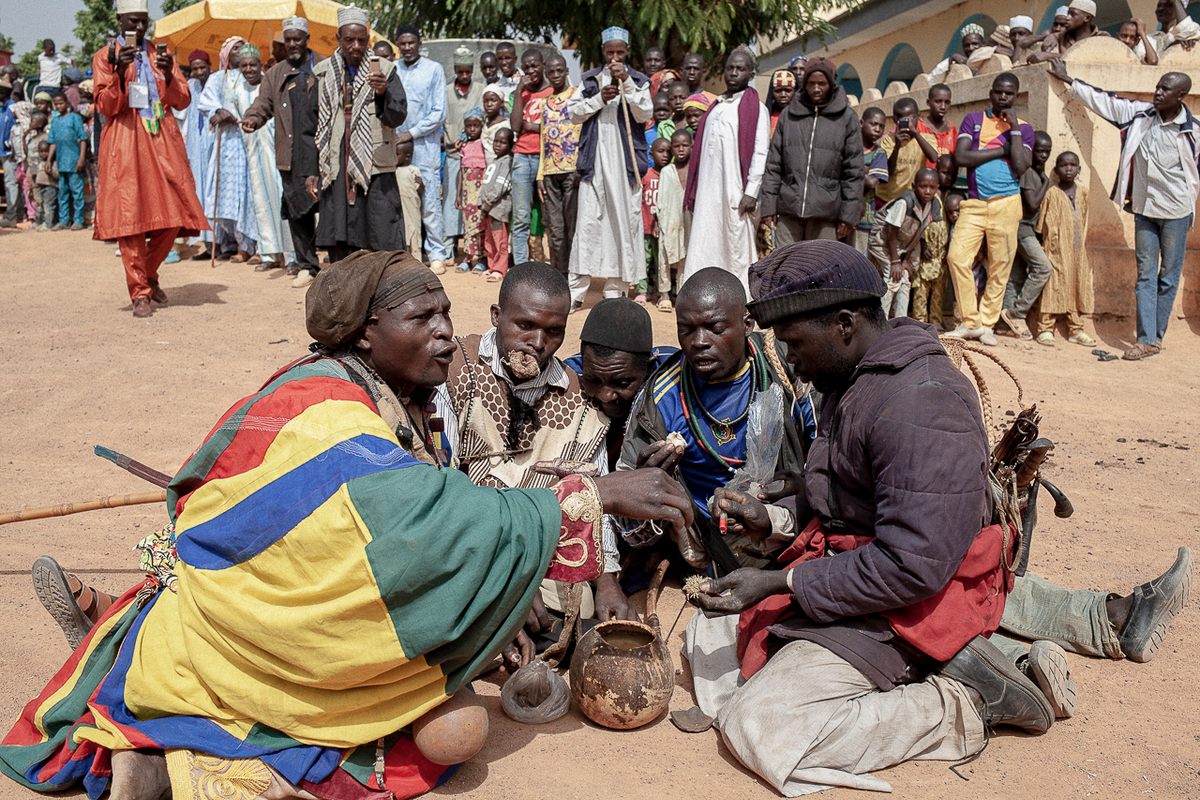
The Festival That Celebrates Anti-Colonial Struggle in Cameroon
On and around Mount Djim, the Nizà’à people tell the story of finding refuge and fighting back.
On a warm day in February 2018, a nimble 63-year-old named Oumarou Alim leads the way through the dramatic stone caves of Mount Djim, a rocky peak in the Central African nation of Cameroon. Holding up an arm with a flourish, he declares that this cave “holds the traces of those who came before us.”
Mount Djim is said to be the place where Alim’s ancestors—members of the Nizà’à people, one of more than 200 ethnic groups that live in Cameroon—staged a resistance against two waves of colonization. Every year, hundreds of people gather for an epic festival that celebrates this history of struggle. Alim, who has 19 children, is one of the local leaders who narrates the story.
The first wave of colonization came in the early-19th century, when an Islamic scholar named Usman dan Fodio led an uprising against the Hausa people in what is now northern Nigeria. As dan Fodio’s forces recruited followers and spread into present-day Cameroon, they also enslaved huge numbers of people under the Sokoto Caliphate. Mount Djim, Alim says, is the place where the Nizà’à found refuge and escaped that somber fate.

Alim slides through a narrow space between rocks and a sudden breath of fresh, humid air hints that water flows nearby. This meager stream, Alim continues, helped the Nizà’à survive for years without leaving Mount Djim. In a larger cave, farther away, a hut made from soil stands intact on a rock. It once stored the food that sustained this community. From here, it’s easy to understand why Mount Djim was a strategic refuge: Through a slit in the granite, the savannah is visible more than 4,300 feet below.
The second wave of colonization came from Europe. In the 1880s, after German colonizers built plantations across West Africa, the German Empire seized the lands it called Kamerun. Germany referred to its colony as a protectorate, but protection was not what came. The Germans exploited trade routes, extracted agricultural products, and profited from the slave trade.
But they also encountered resistance. Standing on a rock plateau, Alim gives the Nizà’à account. “A chief was betrayed and [the Germans] tied [him] to this tree by the beard,” he says, acting out his story and pointing to a lone, stunted tree. “When the Germans tried to kill him, he resisted rafts of gun fire.” According to Alim, the chief killed the traitors on a rock. “Look at the white traces,” he goes on. “That is left by the blood spilling out of the traitors’ beheaded bodies.” Similarly, in nearby Yoko, Tibati, Ngaoundéré and Mora, local people took up arms and amulets to battle the colonizers and their guns. As Alim tells it, all but the Nizà’à eventually gave up.

These stories of resistance would not have been welcome under decades of European rule. During World War I, the French and the British took control of the region. Only in 1960 and 1961 did both nations give up the territory. Finally, Cameroon united as one country.
In the town of Galim Tignère, however, the history lives on in the yearly Mvouri festival. Hassimi Sambo, a slender archaeologist and the first Nizà’à to earn a university degree, made the festival the center of his academic research. On the first day of the celebrations, he stands proudly in the Nizà’à Royal Cemetery atop Mount Djim and explains the history to a diverse crowd. The mountain “is a place of memory, where an epic moment of the Nizà’à history unfolded,” he says. “It is a strategic zone for security and defense, but also a place where the cult of our ancestors is preserved.”
As Hassimi speaks, spectators circle a hut, on top of which are three pitchforks. They symbolize three chiefs—Wànn Mansourou (1842-1862), Wànn Ngù (1862-1878), and Wànn Njómna (1878-1915)—who led Nizà’à resistance movements. The guests have come from all over Cameroon for the opening ceremony, dressed in an eclectic mix of imported clothes, hunter garb, and wax-coated bubus. In front of the crowd, a bony, elderly man designated as the Prince of Mount Djim places ritual offerings of food under a granite rock, to feed the ancestors’ spirits. Then, from the hut’s low entrance, he pours ceremonial wine on the ground while participants recite their hopes of good fortune, good health, and marriage.
Around midday, the hot sun starts to disperse the crowd. Some climb higher rocks, trying to catch a glimpse of artifacts that mark the Nizà’à occupation of Mount Djim. Others run down to Galim Tignère for the many rituals that come next.

Back in town, by the palace of the highest local authority, the Lamido, men on horseback kick sand into the dry air. They race each other, then rear their horses. This demonstration, called Fantasia, was adopted from the Nigerians who once fought against the Nizà’à. Local authorities, dressed in traditional fighting attire, raise their weapons in solemn salutations to the Lamido. Most possess weaponry that was inherited from their grandparents or great-grandparents. “Who knows how many Germans this weapon has killed,” one of them says. “Maybe five, maybe 10, or more.”
Hassimi Sambo stands off to one side, greeting locals and narrating the events. “The re-enactments of the Mvouri festival are the commemoration of the Nizà’à myth,” he says. “The staging of past resistance is part of our community’s identity.”
Mamadou Bouba, one of Sambo’s mentors and the head of the history department of Ngaoundéré University, views the festival as a form of resistance against ignorance. “Colonization was not accepted by all Africans,” Bouba says. “Showing its negative impacts would provoke new questions about this invasion that was presented as a humanitarian and civilizing mission. The Mvouri festival is important to fight against forgetting history.”
For the Nizà’à people who live in Galim Tignère, the newest form of resistance is learning to write their language. There are hundreds of languages and dialects in Cameroon, and Nizà’à is spoken by only a couple hundred people around Mount Djim, where the last descendants of the rebellious chiefs live. In a freshly painted pink house called the Center for Nizà’à Literature, which was partially financed by Christian missionaries, 35-year-old Hamadjoda Yougouda teaches language classes. He learned to write it in 1993. “This language is disappearing,” he says. “The only way to save it is learning to read and write it.”



























Follow us on Twitter to get the latest on the world's hidden wonders.
Like us on Facebook to get the latest on the world's hidden wonders.
Follow us on Twitter Like us on Facebook